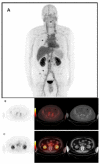Molecular imaging of urogenital diseases
- PMID: 24484747
- PMCID: PMC3912464
- DOI: 10.1053/j.semnuclmed.2013.10.008
Molecular imaging of urogenital diseases
Abstract
There is an expanding and exciting repertoire of PET imaging radiotracers for urogenital diseases, particularly in prostate cancer, renal cell cancer, and renal function. Prostate cancer is the most commonly diagnosed cancer in men. With growing therapeutic options for the treatment of metastatic and advanced prostate cancer, improved functional imaging of prostate cancer beyond the limitations of conventional CT and bone scan is becoming increasingly important for both clinical management and drug development. PET radiotracers, apart from ¹⁸F-FDG, for prostate cancer are ¹⁸F-sodium fluoride, ¹¹C-choline, and ¹⁸F-fluorocholine, and (¹¹C-acetate. Other emerging and promising PET radiotracers include a synthetic l-leucine amino acid analogue (anti-¹⁸F-fluorocyclobutane-1-carboxylic acid), dihydrotestosterone analogue (¹⁸F-fluoro-5α-dihydrotestosterone), and prostate-specific membrane antigen-based PET radiotracers (eg, N-[N-[(S)-1,3-dicarboxypropyl]carbamoyl]-4-¹⁸F-fluorobenzyl-l-cysteine, ⁸⁹Zr-DFO-J591, and ⁶⁸Ga [HBED-CC]). Larger prospective and comparison trials of these PET radiotracers are needed to establish the role of PET/CT in prostate cancer. Although renal cell cancer imaging with FDG-PET/CT is available, it can be limited, especially for detection of the primary tumor. Improved renal cell cancer detection with carbonic anhydrase IX (CAIX)-based antibody (¹²⁴I-girentuximab) and radioimmunotherapy targeting with ¹⁷⁷Lu-cG250 appear promising. Evaluation of renal injury by imaging renal perfusion and function with novel PET radiotracers include p-¹⁸F-fluorohippurate, hippurate m-cyano-p-¹⁸F-fluorohippurate, and rubidium-82 chloride (typically used for myocardial perfusion imaging). Renal receptor imaging of the renal renin-angiotensin system with a variety of selective PET radioligands is also becoming available for clinical translation.
© 2013 Elsevier Inc. All rights reserved.
Figures







References
-
- Jemal A, Siegel R, Xu J, Ward E. Cancer statistics, 2010. CA Cancer J Clin. 2010 Sep-Oct;60(5):277–300. - PubMed
-
- Yap TA, Zivi A, Omlin A, de Bono JS. The changing therapeutic landscape of castration-resistant prostate cancer. Nat Rev Clin Oncol. 2011 Oct;8(10):597–610. - PubMed
-
- Crawford ED, Flaig TW. Optimizing outcomes of advanced prostate cancer: drug sequencing and novel therapeutic approaches. Oncology (Williston Park) 2012 Jan;26(1):70–77. - PubMed
-
- Walczak JR, Carducci MA. Prostate cancer: a practical approach to current management of recurrent disease. Mayo Clin Proc. 2007 Feb;82(2):243–249. - PubMed
Publication types
MeSH terms
Substances
Grants and funding
LinkOut - more resources
Full Text Sources
Other Literature Sources
Miscellaneous

